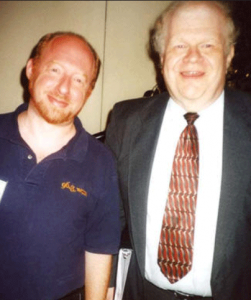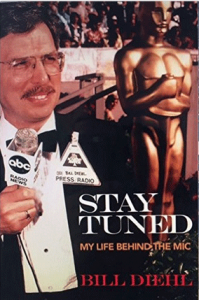NorthEast Radio Watch 3/31/2025: Jim Quinn Signs Off
In this week’s issue… Remembering Pittsburgh's Quinn - Seven Mountains enters Harrisburg - My launches new brands - Ryan out at B101 - More cuts at Radio Vermont - Another AM deleted
In this week’s issue… Nexstar, Sinclair partner for ATSC 3.0 – and what of Sinclair and Tribune? – Remembering Bob Smith, Maine’s Don Brown – Hall of Fame inductions
By SCOTT FYBUSH
*As broadcast television prepares for its next big transition, there are two parallel stories developing this week that both seem poised to put Sinclair at the center of the TV landscape over the next few years – and yet, unless we’ve missed something, nobody’s put all the pieces together until now.
 Sinclair has, of course, been very much in the headlines over its rumored bid to acquire the big-market TV licenses of Tribune Broadcasting. Such a deal, which would be valued well into the billions of dollars, would give Sinclair entree into Los Angeles (KTLA), Chicago (WGN), Dallas (KDAF) and other big markets around the country – as well as several of the big markets in NERW-land where Sinclair doesn’t yet have stations.
Sinclair has, of course, been very much in the headlines over its rumored bid to acquire the big-market TV licenses of Tribune Broadcasting. Such a deal, which would be valued well into the billions of dollars, would give Sinclair entree into Los Angeles (KTLA), Chicago (WGN), Dallas (KDAF) and other big markets around the country – as well as several of the big markets in NERW-land where Sinclair doesn’t yet have stations.
In New York, that’s WPIX (Channel 11), plus its sister stations in Philadelphia (WPHL channel 17), York/Harrisburg (WPMT channel 43) and Hartford (WTIC-TV Channel 61 and WCCT-TV channel 20).
Match those markets up with Sinclair’s current extensive footprint across the region, and the Smith family would end up with very little overlap (WPMT shares a market with Sinclair’s WHP-TV) and very few missing pieces. A full-on Sinclair/Tribune combination would still miss Boston (where Tribune sold WLVI to Sunbeam almost a decade ago) and a handful of smaller markets such as Bangor, Burlington, Utica, Binghamton, Elmira, Watertown and Erie.
There are, of course, plenty of regulatory hurdles such a deal would have to overcome, most notably the FCC’s current ownership cap based on nationwide coverage. If any company is poised to overcome those hurdles, though, it’s probably Sinclair, given its close ties to the current administration in Washington and given the current deregulatory trend.
*Beyond the obvious allure of expanding its footprint into Tribune’s big markets and of Tribune’s national cable presence via WGN America, though, there’s reason to think that Sinclair has another reason to want to move quickly to gain control of as much RF real estate as possible.
Read on as we explain…

And if you don’t have your Tower Site Calendar, now’s the time!
If you’ve been waiting for the price to come down, it’s now 30 percent off!
This year’s cover is a beauty — the 100,000-watt transmitter of the Voice Of America in Marathon, right in the heart of the Florida Keys. Both the towers and the landscape are gorgeous.
And did you see? Tower Site of the Week is back, featuring this VOA site as it faces an uncertain future.
Other months feature some of our favorite images from years past, including some Canadian stations and several stations celebrating their centennials (buy the calendar to find out which ones!).
We still have a few of our own calendars left – as well as a handful of Radio Historian Calendars – and we are still shipping regularly.
The proceeds from the calendar help sustain the reporting that we do on the broadcast industry here at Fybush Media, so your purchases matter a lot to us here – and if that matters to you, now’s the time to show that support with an order of the Tower Site Calendar. (And we have the Broadcast Historian’s Calendar for 2025, too. Why not order both?)
Visit the Fybush Media Store and place your order now for the new calendar, get a great discount on previous calendars, and check out our selection of books and videos, too!
[private]
*The second piece of the puzzle this week comes from our TV Technology colleague Deborah McAdams, who broke the news that Sinclair and its medium-market rival Nexstar are joining forces for a spectrum-sharing partnership that will help to aid the next piece of TV’s big transition, the upcoming move from the current ATSC 1.0 standard to the new ATSC 3.0 standard.
McAdams reported on Wednesday that the two companies are creating “a consortium that will promote spectrum aggregation, innovation and monetization and enhance their abilities to compete in the wireless data transmission sector.”
 Say what? Here’s our understanding of the deal: while the spectrum auction finds wireless carriers paying billions of dollars to acquire the rights to what are now TV channels 38-51, Sinclair, Nexstar and other broadcasters are sitting on RF they already own – if only they can move the industry more quickly into ATSC 3.0 so it can be used for more than just one-way TV broadcasting.
Say what? Here’s our understanding of the deal: while the spectrum auction finds wireless carriers paying billions of dollars to acquire the rights to what are now TV channels 38-51, Sinclair, Nexstar and other broadcasters are sitting on RF they already own – if only they can move the industry more quickly into ATSC 3.0 so it can be used for more than just one-way TV broadcasting.
To get there, though, means finding a way to speed up the move away from ATSC 1.0, which is why Sinclair is eager to partner with Nexstar and other broadcasters. As part of the consortium, for example, Sinclair and Nexstar could hypothetically agree to put all of their ATSC 1.0 signals in Providence (NBC from Sinclair’s WJAR, ABC and Fox from Nexstar’s WPRI/WNAC) on WJAR’s RF signal while launching ATSC 3.0 broadcasts on WPRI’s RF signal – and once ATSC 1.0 goes away, that extra RF spectrum could also go to ATSC 3.0 and be used for all sorts of things potentially more valuable than over-the-air TV in the 21st century.
Which brings us back to that Tribune deal: if Sinclair’s real goal here is to build a nationwide RF footprint, the combination of the Nexstar alliance (which fills in many smaller-market gaps) and the potential purchase of the Tribune signals begins to edge Sinclair close to that 100% goal, even before it attracts other broadcasters to its spectrum alliance, as it says it intends to do.
*NERW subscribers, of course, have access to our exclusive spreadsheet listing of everything we know so far about the repack’s reshaping of the TV landscape around the region. While Nexstar has been secretive about its plans, NERW has learned of one big development in western MASSACHUSETTS, where WCDC (Channel 19/RF 36) has reportedly been sold in the auction. The satellite of Albany ABC affiliate WTEN (Channel 10) is one of the oldest UHF signals in the region, with a powerful signal from Mount Greylock.
And we’re still awaiting word from a few other secretive parties – big-market public broadcasters WGBH in Boston and WNET in New York aren’t talking about their plans, and we’ve heard WGBH has gone so far as to impose a non-disclosure agreement on the planning sessions it’s had with other Boston broadcasters. What’s their strategy when making the choice between the immediate windfall of spectrum auction money and the potential for ATSC 3.0 revenue down the road? Stay tuned…
*Here in western NEW YORK, a routine “Morning Edition” fill-in for your editor on Friday morning took a sad turn just after 9 AM as the news broke of the death of veteran WXXI (1370 Rochester) talk host Bob Smith.
 Bob was just 20 when he started doing news at WHEN (620 Syracuse) in 1973. He left the next year to focus on his graduate studies at Cornell (he eventually got his Ph.D. in American history there), but he soon returned to radio, working at Buffalo’s WKBW, Rochester’s WAXC and Buffalo’s WBEN. The family business called in the mid-80s, when Bob helped run Smith Rubber Company for his father, but he returned to radio in 1988 to launch the new “1370 Connection” midday talk show for WXXI.
Bob was just 20 when he started doing news at WHEN (620 Syracuse) in 1973. He left the next year to focus on his graduate studies at Cornell (he eventually got his Ph.D. in American history there), but he soon returned to radio, working at Buffalo’s WKBW, Rochester’s WAXC and Buffalo’s WBEN. The family business called in the mid-80s, when Bob helped run Smith Rubber Company for his father, but he returned to radio in 1988 to launch the new “1370 Connection” midday talk show for WXXI.
And for 25 years, that became the highlight of Bob’s career. His photographic memory and amazing knowledge of subjects far and wide made him an ideal choice to be the one-man production/booking/hosting staff of a daily two-hour show. When he wasn’t on the air, he was one of the earliest radio people to become active on the nascent internet, taking part in discussions on Compuserve, AOL, the early Usenet and eventually on every online radio forum known to humankind. (For many years, Bob also hosted the weekend “Sound Bytes” computer show on WXXI, helping to feed his love of technology.)
Bob suffered a massive stroke days before his 60th birthday in April 2013, ending his radio career. (The show became “Connections with Evan Dawson” at the start of 2014; your editor, meanwhile, served as an interim host/producer and continues to fill in there.) In recent years, Bob had been in a nursing home in Rochester, receiving a constant stream of visitors who kept him connected with the outside world. He was just 63 when he died early Friday morning; a few hours later, Dawson presented a memorial show on “Connections” (you can hear it here). Calling hours will be held Tuesday for Smith, followed by a funeral Mass Wednesday morning.
(The photo above shows your editor with Bob, who was the keynote speaker at the 2010 National Radio Club convention in Rochester; photo courtesy John Malicky.)
Meanwhile, the Rochester Media Association has named its Impact Award recipients for 2017, including WXXI’s Dawson in the radio category. He’ll be joined by former WHAM-TV (Channel 13) reporter Patrice Walsh in the TV category and veteran Democrat and Chronicle scribe Jim Memmott in the print category when the awards are handed out May 13 at the Rochester Riverside Convention Center.
 *In other news from western New York, former WBEN (930) news director Steve Cichon is taking a step into politics, exploring a run for the Democratic nomination to be the next Erie County clerk. Cichon has been both visible and busy since leaving WBEN a few years back, freelancing for the Buffalo News and speaking and writing about Buffalo history under the “Buffalo Stories” banner. (He just bought a tour bus, too, and is scheduling Buffalo history tours over the next few months.)
*In other news from western New York, former WBEN (930) news director Steve Cichon is taking a step into politics, exploring a run for the Democratic nomination to be the next Erie County clerk. Cichon has been both visible and busy since leaving WBEN a few years back, freelancing for the Buffalo News and speaking and writing about Buffalo history under the “Buffalo Stories” banner. (He just bought a tour bus, too, and is scheduling Buffalo history tours over the next few months.)
Cichon could have media competition in that race – former WKBW (Channel 7) anchor Joanna Pasceri, who’s now working as a government spokesperson, has been rumored as a possible Republican candidate for the seat.
Over at WIVB (Channel 4), Lisa Polster is now news director, removing “interim” from her title at the Nexstar-owned CBS affiliate.
In Canandaigua, WRSB (1310) applies for another power increase from its present 1 kW day; after a proposal for 2.5 kW days/1.3 kW nights was turned down because of potential interference, the sports signal is now applying for 2.2 kW days/1 kW nights.
In the Hudson Valley, Van Ritshie is back on the morning airwaves, now at Bud Williamson’s WALL (1340 Middletown) and its network of translators. Ritshie’s addition displaces Mark West, who’s now heard at night on WALL while working as the station’s production director.
 And while Bill Diehl became a major network name at ABC Radio News, he’s never forgotten his roots in the Southern Tier. Diehl, now a freelancer for the slimmed-down ABC operation, has a new book out called “Stay Tuned: My Life Behind the Mic,” and he talked to the Leader in Corning about his beginnings there at the old WCLI (1450/106.1), where he worked under news director Dick Tobias, who’d later go on to his own big things here in Rochester.
And while Bill Diehl became a major network name at ABC Radio News, he’s never forgotten his roots in the Southern Tier. Diehl, now a freelancer for the slimmed-down ABC operation, has a new book out called “Stay Tuned: My Life Behind the Mic,” and he talked to the Leader in Corning about his beginnings there at the old WCLI (1450/106.1), where he worked under news director Dick Tobias, who’d later go on to his own big things here in Rochester.
*A station sale in southern NEW JERSEY: Quinn Broadcasting’s WMVB (1440 Millville) is being sold to Martin Muniz for $100,000.
*In PENNSYLVANIA, Seven Mountains has changed another set of calls at the stations it’s acquiring in Wellsville, where the venerable WNBT (1490) becomes WNDA.
*In central MAINE, the “bright good morning voice” for a generation of listeners was Don Brown, whose tenure at WABK (1280/104.3) in Gardiner lasted from 1968 until 2012, when he parted ways with Blueberry Broadcasting in what he described at the time as an “amicable” split. Brown, who died Friday at 72, was still high school student Don Wormwood when he started out on the radio at hometown WIDE (1400 Biddeford); he worked in Portland TV on Dave Astor’s teen dance show from 1957 until 1965 and later spent time at WKCG (101.3 Augusta) and “Cruisin’ 93.5” (WCTB Fairfield) before being felled by a series of strokes. Brown had been inducted into the Maine Broadcasters Hall of Fame in 2006, and he’s fondly recalled as a mentor by many younger Maine broadcasters.
 *A format change up north in NEW HAMPSHIRE: WBNC (1340 Conway/W237BX 95.3) dropped its previous travelers’ information programming last week to become “Easy 95.3,” playing a soft AC format that Ron Frizzell of owner Mount Washington Radio & Gramophone describes as a “direct and tested response” to the lack of programming for the over-50 audience that makes up more than half of the valley’s population. Karen E. Williams, who’d been heard on sister station WMWV (93.5), will be the daytime voice for the station.
*A format change up north in NEW HAMPSHIRE: WBNC (1340 Conway/W237BX 95.3) dropped its previous travelers’ information programming last week to become “Easy 95.3,” playing a soft AC format that Ron Frizzell of owner Mount Washington Radio & Gramophone describes as a “direct and tested response” to the lack of programming for the over-50 audience that makes up more than half of the valley’s population. Karen E. Williams, who’d been heard on sister station WMWV (93.5), will be the daytime voice for the station.
*The RHODE ISLAND Radio Hall of Fame has named its Class of 2017, to be inducted May 4 in Lincoln. This year’s inductees include Frank Kingston Smith, known for long runs in New York and Boston after his start at WICE; veteran general manager Dick Rakovan (WPRO, Outlet Broadcasting); WPRO PD Tony Mascaro; the late talk host Myrna Lamb of WHJJ and WPRO; Frank Laliberte, co-owner of WNRI in Woonsocket; and Jay Beau Jones (aka “Johnny Dowd”), the veteran DJ who worked at WPJB from 1979-1984.
 RIRHOF’s Shepard Award will go to pioneering newscaster Mowry Lowe, while the old WICE (1290) gets “Legacy Station of the Year.”
RIRHOF’s Shepard Award will go to pioneering newscaster Mowry Lowe, while the old WICE (1290) gets “Legacy Station of the Year.”
*There’s a new morning show in CANADA‘s biggest market, where CIND (Indie 88) launches “The Josie Dye Show” this morning from 6-10. Dye, who’s worked in radio at CFNY (102.1 the Edge) and in several TV gigs, will join current morning hosts Matt Hart and Carlin Burton for the new show.
Gary Miles worked his way up from radio announcing to sales to local management, eventually becoming vice president of Selkirk Radio, president of the Radio Bureau of Canada and then, in 1994, CEO of Rogers Radio. He grew the group to 52 stations, making it one of the biggest radio companies in Canada before retiring in 2008. Miles died Tuesday at 78; his life was celebrated at a party in Toronto Saturday night.
And in Hamilton, they’re mourning Kerry Gray, who had worked at CHTZ in St. Catharines, CJAQ in Toronto and CJDV in Cambridge before taking over the morning show at CJXY (Y108) in 2008. Gray, who left the “Ben and Kerry” morning show in 2013, had been working in Red Wing, Minnesota while undergoing treatment at the Mayo Clinic for brain cancer. He was just 50 when he died Thursday.
[/private]
From the NERW ArchivesYup, we’ve been doing this a long time now, and so we’re digging back into the vaults for a look at what NERW was covering one, five, ten, fifteen and – where available – twenty years ago this week, or thereabouts. Note that the column appeared on an erratic schedule in its earliest years as “New England Radio Watch,” and didn’t go to a regular weekly schedule until 1997. One Year Ago: March 21, 2016
The perpetually-troubled WBAI has survived the loss of its rented studio space, investigations from the Corporation for Public Broadcasting, multiple changes of management and every manner of financial instability known to nonprofit radio. Now, though, it appears a combination of problems all at once might finally force Pacifica to do what it’s long resisted – liquidating the assets of WBAI, including its commercial class B license. The pressure this time comes from multiple directions: there’s WBAI’s ongoing difficulty in making timely rent payments to the Empire State Building for its transmitter space; there’s WBAI’s even more ongoing difficulty in making payroll and health insurance payments and its mandatory “central service fees” to Pacifica national; and now there’s a pending lawsuit from Gary Null, the veteran WBAI program host who says the station defrauded members by providing inferior substitutes for the videos and diet supplements he hawked as pledge premiums. Former WBAI GM Chris Albertson, who’s been tracking the troubles at the station, monitors the doings of Pacifica’s national finance committee, and he reports that last week’s meeting included a presentation from Pacifica’s new national CFO Sam Agarwal that made some tough recommendations for WBAI. *A longtime VERMONT streaming operation is making a jump to FM. Tony Gallucci and Eric Koval have been running “WBKM, Burlington’s Kinda Music” for eight years at wbkm.org – and now they’re on the FM dial on what used to be WNMR (107.1 Dannemora NY). The AAA-formatted webcaster is leasing the FM signal from Randy Michaels’ RadioActive with the intent to buy the license down the road.
Five Years Ago: March 19, 2012 *For all of the consolidation that”s changed the U.S. media landscape in the last two decades, it doesn”t even begin to compare with what”s taken place fairly quietly in CANADA over that same period. Not only have independent station owners like Allan Waters” CHUM Group and Gary Slaight”s Standard Broadcasting been swallowed up by larger corporate players, those big corporate players have (unlike most of their counterparts south of the border) combined big radio clusters with equally massive holdings in broadcast. cable and satellite TV, newspapers and wireless service.
From Bell”s vantage point, bringing Astral into the fold is primarily about television, and more specifically about French-language television in Quebec. That”s been a weak spot in Bell”s portfolio, and the company”s continued growth into pay television service has meant that it”s been paying lots of money to Astral to carry Astral-owned channels such as Super Écran, The Movie Network and HBO Canada. But along with the Astral TV networks, the deal also brings 84 radio stations to Bell, joining the 35 stations the company already owns – and that means the CRTC will have some interesting decisions to make on the way to what”s probably the inevitable approval of this latest mega-deal. As the indispensable Steve Faguy notes in his of the Bell/Astral fallout, Bell already controls 31% of radio listening across Canada. That number would climb to 45% of listenership and nearly a third of all Canadian radio revenue if Bell were allowed to keep all of Astral”s stations. It won”t be, of course – but it could end up retaining a surprisingly large chunk of Astral once the dust settles.
Ten Years Ago: March 19, 2007 *When one of your town”s most famous citizens is Stephen King, you probably don”t want to get him publicly riled up – especially if you”re the University of MAINE, and it”s King”s radio stations that have been the flagship carriers for your sports coverage for many years.
Promoting the move on WVOM”s morning show Thursday, station officials said it would give the broadcasts a wider reach across Maine, as well as restoring former Maine sports play-by-play voice George Hale to a role in the broadcasts. (While semi-retired, Hale still does some work with WVOM, a sister station to his longtime broadcast home, WABI 910.) King and his wife Tabitha have been frequent donors to the university, and he fired back on the station”s website Thursday: “Tabby and I are very disappointed with the University”s decision to move its sports broadcasting rights to Clear Channel, a company which is based far from the college it will be serving. We understand that monetary considerations were a prime consideration, but feel the Athletic Department in particular and the University in general may not understand that making money the prime consideration in any dealing is usually short-sighted. My wife and I feel that may prove to be the case here; we feel that what UM Athletics has gained for their programs may be offset by a loss in the area of community relations.” As with any good Stephen King yarn, there”s another twist to the story: the Bangor stations are among the more than 400 nationwide that Clear Channel is trying to sell. Bids for the cluster were due a few weeks ago, and Clear Channel is expected to announce a buyer for the Bangor group any day now. Executives there say the sale won”t affect the UMaine deal, whatever happens. Comments from listeners on the Bangor Daily News website over the weekend were strongly on the side of the Kings and WZON, and it will be interesting to watch this dispute play out. We”ll be following it here on NERW. *In other news from New England, there”s yet another TV station sale to report in RHODE ISLAND (though technically, this one”s a MASSACHUSETTS station), as Freedom Communications has reached a deal to sell ABC affiliate WLNE (Channel 6) to Global Broadcasting LLC for an as-yet-undisclosed price.
Will the arrival of O”Brien and partner Robinson Ewert be less tumultuous at WLNE, which is sitting firmly in third place in the Providence market under Freedom? If nothing else, Global enters at a time when the rest of the market”s unsettled, too – Media General just recently took over WJAR (Channel 10) from NBC, while CBS is in the process of spinning off CW affiliate WLWC (Channel 28) to new owners, leaving only the LIN duopoly of WPRI (Channel 12) and WNAC (Channel 64) under stable ownership at the moment. *In MASSACHUSETTS, Bob Bittner is trying something new at his standalone AM station, WJIB (740 Cambridge). We”ve reported in recent months on Bob”s struggle with music rights fees, which have skyrocketed now that WJIB has begun to make regular appearances to the left of the decimal point in the ratings. WJIB also lost the income it was receiving from leasing two morning weekday hours to Radio France International, and now Bob says he needs to raise $88,000 this year just to keep the lights on. The result: an announcement last week that WJIB will experiment with listener support. If Bob can raise the needed money by June 30, he”ll keep his standards format on the air at WJIB with no commercials and only a few interruptions (mostly for the Sunday church services that help keep the station afloat.) If he doesn”t get enough money by June 30, Bob says he”ll return whatever donations have come in by then – and he”ll have some tough decisions to make. He doesn”t want to air commercials, so one possibility is that WJIB may go up for sale. Whaever happens, Bob says his other station, WJTO (730) in Bath, Maine, is safe, since it”s not under the royalty-fee pressure that WJIB faces. *It”s either the worst-kept secret in western PENNSYLVANIA radio or some really clever stunting, but we”re betting that the impending format change at CBS Radio”s WRKZ (93.7 Pittsburgh) is for real. If blog postings from former WDVE stalwart Scott Paulsen and former KDKA talk host John McIntire are to be believed, “K-Rock” will relaunch April 2 as “The Zone,” with FM talk and a lineup that will include Paulsen in afternoon drive. WRKZ already airs Opie & Anthony”s syndicated morning show, which will stay, and the rumor mill suggests some of CBS” “Free FM” offerings from elsewhere in the country will fill some of the less-prime slots in the “Zone” schedule. Fifteen Years Ago: March 25, 2002 Over the last few years, we”ve seen Clear Channel enter plenty of markets in NERW-land (and beyond) with “Kiss”-branded CHR stations, often challenging entrenched CHR competitors. But it”s rare to see one of those competitors change course as quickly as in Harrisburg, PENNSYLVANIA, where Cumulus pulled the plug on CHR at “Wink 104” (WNNK 104.1) last week after more than a decade and a half in the format. The move comes less than a year after Clear Channel flipped oldies WWKL-FM (99.3) to “Kiss” as WHKF; despite a much smaller signal, WHKF had pulled even with WNNK in the 12 numbers by the most recent book. It didn”t help, either, that WNNK parted ways with afternoon host Bruce Bond, one of the market”s best-known personalities, last winter. (We hear Bond just might resurface in the market as an AM talker once his non-compete expires, by the way…) WNNK is still “Wink 104,” but it”s competing in the hot AC arena now, offering up “The Best Music of the 80s, 90s and Today” and adding older tracks by Celine Dion and the like to the playlist. A bit of radio history died last week with the passing, at age 95, of the Rev. Dr. Carl McIntire. He was best known, perhaps, as the rabidly right-wing preacher whose “Reformation Hour” was heard on the radio from the 1960s until his recent retirement, but in radio circles he”ll be forever known for the license revocation of WXUR and WXUR-FM in Media, near Philadelphia, in 1973. The FCC revoked the stations” licenses after finding they had violated the (now-defunct) Fairness Doctrine by refusing to present the views of those opposed to McIntire”s fiery anti-Communist, anti-modernist editorials. After the stations were silenced (the AM frequency, 690, reappeared later in the seventies as WPHE Phoenixville, while the FM side remained dark until 1983 when it reappeared as WKSZ, now WPLY), McIntire moved his operation to a ship anchored off the New Jersey shore, from which he operated on 1160 kHz for a few days until a fire broke out and destroyed much of the equipment. McIntire never attempted to return to radio ownership after that, but his commentaries continued to air (most recently on WTMR in Camden) until he ceased producing them three years ago. He died Tuesday (March 19) in Voorhees, N.J. Moving across to NEW JERSEY, the FCC has approved one of the longest-delayed transactions on the table: the sale of WNJO (94.5 Trenton) and WCHR (920 Trenton) from Great Scott Broadcasting to Nassau. The approval came as part of the Commission”s attempt to clear a backlog of transactions that had been flagged for market-concentration issues; while WNJO-WCHR and four other old transactions were greenlighted, the FCC told Clear Channel it could not acquire WUMX in Charlottesville, Virginia, setting up a potential new round of challenges to the Commission”s still-vague concentration guidelines. As for WNJO and WCHR, Nassau has been operating them under an LMA for so long that most people in the market probably thought the deal had long since gone through. WBZ-TV (Channel 4) is pulling the plug on its 7 PM newscast on sister station WSBK (Channel 38). It”ll be replaced next month with a 10 PM show on WSBK, the second time in a decade that WBZ has produced a 10 o”clock newscast for WSBK. A pioneer in CANADA”s multilingual broadcasting scene has died. Johnny Lombardi had to fight hard to get the CRTC to approve a station in a language other than English or French, but he won the license for CHIN in Toronto in 1966, eventually expanding to two full-time services on AM and FM, a new construction permit in Ottawa and a weekend schedule of TV (via CITY-TV Toronto), in a total of more than 30 languages. Lombardi, who remained a vibrant presence at CHIN and in Toronto”s Italian community well into his eighties, died Monday (March 18) at 86. His family continues to own the CHIN stations. Twenty Years Ago: March 28, 1997 Live, local, and late-breaking: There”s another urban station in Hartford. Mega Broadcasting has flipped WNEZ (910 New Britain) from Spanish romance music to urban as “910 Jamz.” There”s no urban FM in Hartford; the competition is Windsor”s WKND (1480). Boston”s WCVB-TV (Channel 5) is getting a new owner. Hearst Broadcasting is merging with Argyle Broadcasting, and that means you can now list WCVB as a Hearst-Argyle station. The merger means the company will have to sell WNAC-TV (Channel 64) in Providence, a Fox affiliate operated under LMA by Clear Channel”s WPRI-TV (Channel 12), because of the signal overlap between WCVB and WNAC. Late word is that Hearst is selling its radio properties in Milwaukee (WISN/WLTQ) and Pittsburgh (WTAE/WVTY) to SFX to help pay for the Argyle deal. The Providence market will have another LMA”d TV outlet by next week. WLWC-TV (Channel 28) New Bedford-Providence is due to sign on March 31, operated as a WB affiliate by NBC”s WJAR-TV (Channel 10) Providence. Channel 28 will have a 10pm newscast produced by WJAR-TV. Call letter news: Boston University”s FM station is no longer WBUR(FM). It”s changed calls to WBUR-FM, allowing the former WUOK(AM) in West Yarmouth to become WBUR(AM). WBUR(AM) simulcasts the NPR news and talk programming from WBUR-FM for Cape Cod listeners on 1240. Another historic Boston call has returned to the airwaves. WVBF, the calls associated with 105.7 in Framingham from 1970 until 1993, now can be heard each hour on AM 1530 in Middleborough. The new WVBF(AM) is the former WCEG(AM), and broadcasts programming for the blind from the Talking Information Center in Marshfield. The new public radio station on 91.1 from Nantucket will be WNAN(FM), and Sound of Life”s new religious outlet in Glens Falls NY will be WARD(FM). The WARD calls were last seen on what”s now WKQV(AM) 1550 in Pittston PA. 96.1 in Poughkeepsie NY is no longer WNSX; the new calls there are WTND, reflecting its “Thunder Country” simulcast with WTHN (99.3) Ellenville NY. In business news: Congratulations to Bob Bittner, whose purchase of WJTO (730) Bath ME was approved earlier this month. Bob”s now sorting his way through all the old stuff he”s finding buried deep in the WJTO studio/transmitter facility. WMDI (107.7) Bar Harbor ME has been sold by MDI Communications to Bridge Broadcast Corp. Pilot Communications has sold its radio properties in the Northeast to Broadcasting Partners Holdings LP. The stations include WTVL/WEBB (1490/98.5) Waterville ME; WEZW/WMME (1400/92.3) Augusta ME; and WLTI (105.9), WNSS (1260), WNTQ (93.1) and WAQX (95.7 Manlius) in the Syracuse NY market. WLTI has just been granted a power increase to 4 kW. |
In this week’s issue… Remembering Pittsburgh's Quinn - Seven Mountains enters Harrisburg - My launches new brands - Ryan out at B101 - More cuts at Radio Vermont - Another AM deleted
Tower Site goes Jeeping (and fixing a flat tire!) up in the mountains of northwest New Jersey
In this week’s issue… New signal for Boston's WJIB - "New Standards" changes stations - New home for Maine FM - Remembering NYC's Diaz, Maine's "Mr. Mike," Albany's McGrath, Rochester's Petschke
A look at two of the Voice of America facilities that were abruptly shuttered this month